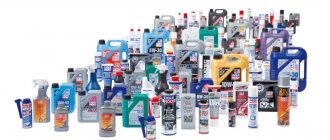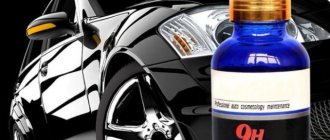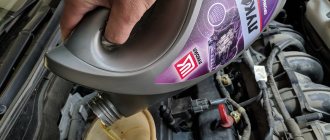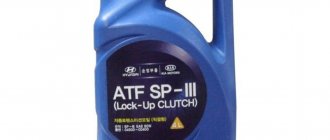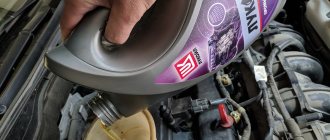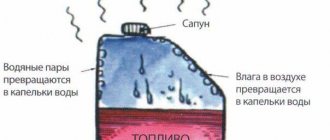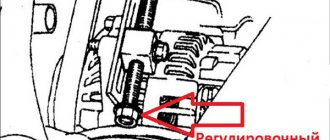The problem of water in the fuel tank is familiar to many motorists. And some of them faced unpleasant consequences.
Currently, special means exist and are also actively used. They are poured into the tank and activated, ensuring rapid and effective removal of water from the fuel.
But before you buy such compositions, you need to understand why the water ended up there in the first place. In some situations, a simple remover will not solve the problem. Serious intervention is required with disassembly of the structure, repair of the tank and other components.
But most often the reasons are obvious and banal. And to combat moisture, it is preferable to choose proven and proven products.
How does water end up in a fuel tank?
Before we talk about what to do if water suddenly appears in the gas tank, you should understand the reasons for its appearance there.
Many people can probably guess where the water in the gas tank could come from. But guesswork is clearly not enough here. It is necessary to accurately determine the cause. This will help prevent similar situations in the future and reduce all risks to a minimum.
It is believed that there are 2 main reasons for water ingress. But you can add two more to them. It is less common, but still exists.
- Condensation. Condensation forms as a result of a sudden change in temperature. The released moisture ends up in gasoline or diesel fuel. Most often this happens in winter. After driving around the cold city, the car drives into a warm garage, where the temperature is clearly above 0 degrees Celsius. As a result, small drops of moisture begin to appear on the inner walls of the fuel tank. They condense and begin to gradually drain, mixing with the fuel. Moreover, cars with a metal fuel tank rather than a plastic one are more susceptible to condensation. This is due to the properties of the metal to take temperature faster. That is, metal has greater thermal conductivity compared to plastic.
- Low quality fuel. A typical problem for many Russian gas stations. To increase profits, unscrupulous gas stations dilute fuel with water. Low-quality fuel also contains large fractions, some of which are moisture. The result of such refills is quite obvious. The tank is filled with an impressive amount of water. Hence all the ensuing consequences.
- Snow and rain. Not the most common situation. But it can happen. When refueling during rain or snow, if the gas tank cap is open, a small amount of moisture may enter. Sometimes even this amount is enough to cause problems.
- Moisture from the filling nozzle. It may be wet from washing, or as a result of condensation. The volumes of water are small, but they still exist.
Next, we’ll find out what water in gasoline can lead to, as well as what to do in such a situation.
Where does the water in the fuel tank come from?
As mentioned above, water is present in small quantities in any fuel tank (both gasoline and diesel). This is due to two factors. The first and most common is simple condensation, which occurs when there is a sudden change in the temperature at which the machine is operated. In winter conditions, this happens when a car drives from the street, where the temperature is significantly below zero Celsius, into a warm garage or box. At the same time, small drops of moisture form on the inner walls of the tank, which condense and drain, settling at the bottom under the fuel. Please note that there will be more condensation on the walls of a metal tank than on the walls of a plastic one! This is due to the fact that the metal quickly acquires the temperature of its environment, that is, it has greater thermal conductivity than any plastic.
The second reason why there is water in the fuel tank is the use of low-quality fuel. This applies to both gasoline and diesel fuel. The fuel can simply be diluted with water or consist of large fractions, including a lot of moisture. This situation is relevant when the car owner refuels at gas stations with a bad reputation or simply pours something like gasoline or other substitute into the tank. Such compositions are stratified in the gas tank, and one of the components is water. In fact, this situation is very dangerous and it is better not to do this, but to try to fill the car with high-quality fuel.
Also, moisture in small quantities can enter the fuel tank when the driver refuels in the rain or snow. When the lid is open, a few drops of precipitation may get inside. Another possibility is that there may also be some moisture on the surface of the fuel nozzle (this could also be condensation or precipitation), which gets into the tank space.
What are the dangers of water ingress?
The bulk of the water in the container settles at the bottom. This negatively affects the operation of the entire fuel system and the engine itself.
As a result, power may drop. Plus, the working elements of the internal combustion engine begin to become actively contaminated.
In the most difficult situations, when the volume of water in the tank has reached a critical level, the air-fuel mixture simply does not ignite. Because of this, it is impossible to start the engine.
But here it’s worth being objective. The consequences discussed mainly apply to older carburetor-type engines.
Nowadays, most cars are equipped with injection engines. Other risks and possible dangerous situations arise here.
The fuel system of an injection engine has a filter that removes water from the mixture. When the air temperature is above zero or the frost is slight, the water on the surface of the filter does not freeze and passes freely.
Everything changes when temperatures drop to -20 degrees Celsius or below. Then there is a high probability that the surface of the water filter in the fuel system will freeze. Ice forms on it. Because of this, fuel is difficult to supply, which leads to problems with starting the engine. Sometimes it simply refuses to start.
There is another danger. It is relevant in cases where the amount of water in the tank is really large. Under the influence of low temperatures, water can freeze. This creates a layer of ice at the bottom of the tank. If frozen water begins to penetrate the fuel pump, it may also freeze. The pump will operate at the limit of its capabilities due to critical loads. And this is a direct road to rapid wear and tear. Including complete failure of the pump.
In the best case scenario, the pump fuse will blow. At worst, you will have to replace the burnt out fuel pump.
Don't forget about the potential problem that specifically concerns metal gas tanks. Corrosion occurs under the influence of moisture. And the longer the water stays there, the sooner full-fledged rust will appear. And behind it is a hole in the tank, through which fuel will pour out first in drops, and then in a stream. It is not difficult to predict the consequences of a gasoline leak.
In addition to the metal fuel tank itself, other metal elements of the fuel system may also suffer from corrosion.
The driver’s actions in such a situation are extremely simple. You need to start removing water from the gas tank. To begin with, it is recommended to fill with high quality fuel. And after that add a special desiccant.
Experts advise periodically using dehumidifiers as a means of prevention. If too much moisture accumulates over time, a dehumidifier alone will not be able to deal with it. You will have to carry out more complex repair work, including removing the gas tank from the car.
How it works
Before you completely get rid of water in the gas tank, you also need to understand the principle of operation of special removers. They are also called moisture neutralizers.
The point is this. The desiccant is based on alcohol. This is usually ethyl or isopropyl alcohol. Alcohols do not react chemically with water, contrary to common myths about how dehumidifiers work. Allegedly, a violent reaction occurs and the water disappears. No, alcohol mixes with moisture. This allows you to get 2 layers of liquid in the tank. At the top is lighter gasoline, and at the bottom is a mixture of water and alcohol.
The composition also includes other additives. But their task is already secondary. Some components are needed to protect against rust, others remove dirt from the walls, and so on.
While the engine is running, the fuel pump draws liquid from the tank. Only now it’s not just water, but an alcohol mixture. Something like vodka. This mixture burns very efficiently together with gasoline or diesel, without creating problems in the combustion chamber.
In fact, instead of a desiccant, you can pour regular alcohol into the tank, and the effect will be the same. But we shouldn’t rush to conclusions here. These are folk remedies that need to be treated very carefully and carefully.
Next, we’ll look at the top best water neutralizers in gasoline and tell you about the features of the most popular and effective products.
Rating of the best dehumidifiers in 2021
It cannot be said that new names and developments appear very often in the dehumidifier segment. There is a certain list of established means. Plus, sometimes newer solutions with proven effectiveness appear on the horizon.
Do you know how to remove water from a car gas tank? Use a neutralizer. The question is different. What kind of moisture remover from a gas tank is best to use?
It will be useful to study the current top 10. It includes the best products in terms of effectiveness. The selection was carried out based on reviews, comments and consumer ratings. But keep one more thing in mind. Before removing water from the gas tank with a product, be sure to read the instructions for use from the specific manufacturer. Each drug has its own characteristics of use. As well as the amount of fuel for which the volume of the bottle with the neutralizer is designed.
Now the rating itself. Each presented water remover has proven its effectiveness in practice and is capable of efficiently draining the gas tank from accumulated moisture.
- Liqui Moly Fuel Protect Anti-ice. In order not to risk removing it with alcohol, it is better to get rid of the water inside the gas tank with this branded product from one of the leading manufacturers. This is a universal dryer suitable for petrol and diesel engines. Consists of alcohols and active ingredients. A completely harmless product for the catalyst or turbine. Additionally protects the system from ice formation and corrosion. Some note not the highest efficiency. Many associate it with improper use or the purchase of counterfeits. A 300 ml bottle is designed for 60 liters of fuel.
- Wynns Dry Fuel. Helps to expel water from a tank with diesel or gasoline, that is, it is also a universal moisture neutralizer. Effectively copes with assigned tasks. Additionally, it has anti-corrosion properties. Does not harm rubber and metal elements, does not interfere with the performance of the catalyst and oxygen sensor. Helps simplify cold starting of the engine during frosts. Reliably resists water crystallization. Tests show average level effectiveness. The capacity is 325 ml. The advantages include the presence of a convenient long spout for easy filling into the neck of the fuel tank.
- Runway Moisture Remover. Another popular product designed to remove water accumulated at the bottom of the gas tank. Only when purchasing it is important to clarify one point. Runway offers 2 types of neutralizers. This is an additive designed to remove water specifically from the gas tank, that is, from cars with a gasoline internal combustion engine. A preparation for diesel engines is sold separately. The product is offered at an attractive price in 300 ml bottles. They are enough for 60 liters of fuel. Does not harm sensors, catalysts, or rubber-metal components. Additionally protects the walls of metal tanks from corrosion. Efficiency is at an average level, according to the results of independent tests.
- Astrohim Moisture-displacing additive. The next additive is designed to remove accumulated water inside the gas tank. Suitable for cars with diesel and gasoline internal combustion engines. A safe preparation for catalysts, oxygen sensors, etc. Removes moisture, defrosts ice, and also prevents water from appearing in the future. The additive is non-toxic due to the absence of methyl alcohol. One bottle is designed for 60-80 liters of fuel. The manufacturer himself advises using the product in winter on an ongoing basis, before each refueling. And in the summer with a mileage interval of 3000 km. Efficiency is average, even slightly higher. The neck of the bottle is long and narrow, which makes pouring into the tank easier.
- Lavr Winter Fuel Dryer. If you need to expel water and also get rid of excess moisture, you can use the development of Lavr. Allows the removal of condensate and ensures safe removal of water. Used on diesel and gasoline engines. It quickly defrosts ice and prevents it from appearing again. The product is absolutely harmless to hoses, metal components, catalysts and sensors. The manufacturer recommends filling before refueling. One container is designed for 40-60 liters of fuel. Now Lavr is one of the most popular neutralizers. This is due to good efficiency. At the same time, the price is quite high compared to competitors. Plus, there is no reliable protection against rust. The package includes a funnel attachment, which simplifies the filling procedure.
- Hi-Gear Fuel Dryer. Quite a popular neutralizer with proven effectiveness in neutralizing water in a gasoline car. That is, it is not suitable for diesel cars. Even the manufacturer himself notes that the drug is intended for winter use. Removes moisture, gets rid of ice, and also blocks attempts to re-form. Harmless desiccant for other components. At the same time, it cleans the fuel line. Tests showed a good level of effectiveness. An excellent choice as a preventative.
- BBF Moisture Remover. The drug binds and removes moisture from the system. The range includes 2 products with identical names. The only difference is that one neutralizer is intended for gasoline internal combustion engines, and the second for diesel engines. So be sure to check the purpose before purchasing. In addition to neutralizing moisture, the product also reduces the pour point and makes it easier to start the engine in cold weather. One bottle is designed for 40-60 liters of fuel. It is recommended to refill every 2-3 refills. Tests showed a decent level of effectiveness. At an affordable price, the drug is one of the best dehumidifiers.
- Step Up Dryer Antifreeze Dryer. A special neutralizer suitable for gasoline engines. These can be carburetor and injection systems, conventional atmospheric and turbocharged internal combustion engines. Acts as a professional auto chemical product. Does not harm other elements of the system. Protects metal from corrosion, increases fuel combustion efficiency, and removes water along with exhaust gases. A high degree of effectiveness has been proven in real tests.
- Xado Aquastop. The manufacturer positions its neutralizer as an effective dryer aimed at gasoline engines. The composition includes alcohol, surfactants, detergent-dispersant additives, etc. As part of the tests, it was proven that the effectiveness of the neutralizer is solid. That’s why many motorists choose this drug to combat moisture in the tank. To achieve maximum performance, you should use the dehumidifier on an ongoing basis, refilling it at intervals of about 5 thousand kilometers.
- Shell BT90I. If this is an option, how can you remove moisture if water got into the fuel and is now in high concentration in gasoline. Currently, this is one of the most effective moisture removers on the Russian market. This is confirmed by various independent tests, reviews from motorists and expert assessments. The dehumidifier is universal, and therefore can be used on diesel and gasoline power units. At the same time, the product has a reasonable price. After entering the tank, it binds water, forming a kind of silicone balls. And then they completely dissolve. The dryer does not harm other components of the fuel system or the engine. Therefore, such a neutralizer can definitely be recommended for use.
But removing moisture inside the gas tank with special means, be it condensation or diluted fuel, is not the only option.
Some motorists practice making their own analogues of additives. Alcohols or solvents are usually used.
Alcohols chosen include ethyl, methyl, and isopropyl. Moreover, methyl alcohol is a dangerous poison that should absolutely not be inhaled. Used as a last resort.
Dosage is approximate. Typically, alcohol is taken in an amount of 200-250 ml per 40 liters of fuel.
As for solvents, acetone and Solvent turned out to be popular for draining gas tanks. They have their own proportions and recommendations for use. If you need 200-250 ml of pure acetone per 40 liters, then you will have to take 300 ml of solvent.
It is impossible to abuse the use of dehumidifiers, both homemade and special factory ones. Fill only as needed and in accordance with the manufacturer's instructions.
No matter how you remove water from your gas tank, use the product very carefully and do not violate the proportions. Otherwise, you will have to deal with the consequences.
This is not a complete list of drugs. But each product presented in the rating performed well in removing water from diesel and gas tanks. Considering the reviews and results of independent examinations, such drugs can be trusted. Another question is whether in your case you really need to deal with moisture. If you fill in high-quality fuel and do not provoke sudden temperature changes, restraining condensation, you will not even need to use dehumidifiers for prevention.
What do you think about fuel dryers? Did you use it often? Which remedy did you choose? Was the result justified?
Subscribe, leave comments, ask questions and tell your friends about the project!
Popular fuel dryers
Let's consider the most popular products intended mainly for winter use. That is, when the problem is most pressing.
- Liqui Moly Fuel Protect. Suitable exclusively for gasoline engines. It not only binds and removes water, but also defrosts ice deposits at the bottom of the tank. The most expensive of all options. It has repeatedly proven its effectiveness in laboratory and real conditions.
- Hi-Gear Gas Dryer Winter Cleaner. A product intended for gasoline engines. It has an effect identical to the additive from Liqui Moly. According to some data, it works somewhat more efficiently and costs less.
- Lavr Universal Winter Fuel Dryer. A universal product that is equally suitable for both diesel and gasoline engines. It works somewhat worse than its competitors, but at the same time it costs less and is compatible with any power supply system. Often used by drivers in the off-season for prevention.
Tests have shown that all of the above dehumidifiers work. Efficiency in general is directly proportional to price.
